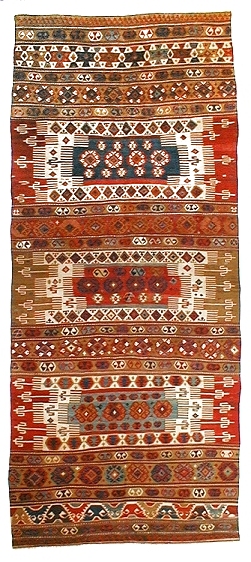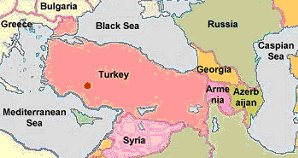
|
Origin: Konya West Central Anatolia Woven: c. 1880 Size: 4.05 x 1.64 m 13'3" x 5'5" Ref: 400BY004 Price Euros 3300
|

|
kilim-warehouse.com
|
 |
|
Konya, previously known as Iconium in Roman times, is thought to be one of the oldest urban centres in the world. According to Phrygian legend, Konya was the first city to rise from the waters after the great flood. Excavations have so far revealed signs of settlement from the Bronze age (3000BC) and Konya is also close to Catal Huyuk, where excavations have revealed urban-like settlements from more than 7500 BC. The Seljuk Turks made Konya their capital in the twelfth century and it was then that it became a centre for Islamic culture and learning, particularly since Rumi, philosopher and founder of the mystical Mevlavi sect ('the Whirling Dervishes') made his headquarters there. From that time Konya became the collection centre for a most prolific weaving area. Distinguished by the use of slitweave technique, Konya kilims were often large and sometimes woven in two or three pieces on a predominantly white or cream background with a strong central series of medallions. Sometimes even one or both borders were made separately, very different from other Anatolian kilims that were usually just made in two halves split in the middle. This particular kilim is woven in one piece, probably in a village house during the days of the 'Ottoman Empire', and has a design and soft colouring, as well as border motifs, clearly denoting its Konya area origin. This design, alternating sections of female and male symbols, mixed with the three central medallions mainly representing 'eyes' with crosses (the eye was thought the best way to reflect the 'evil eye' or bad luck) is undoubtedly a dowry piece for marriage. The high quality of the work also suggests this kilim was made for a very important event. The female or birth motifs are at one end and are very clear 'Ebilbelinde' designs, the symbol for life/birth and the desire for a child. More stylized Ebilbelinde, or 'hands on hip' motifs appear in different rows through the rug. Tree of Life motifs appear around the medallions symbolizing life and the ideal world. Male rams horn motifs occur throughout the rows as well as at either end of the kilim on both borders. These motifs are thought to represent fertility, heroism, power and masculinity. Also the weaver has randomly placed hook motifs, also to ward off the evil eye, around the medallions. All in all, a superb example of this Konya design, and considering its age, in excellent condition.